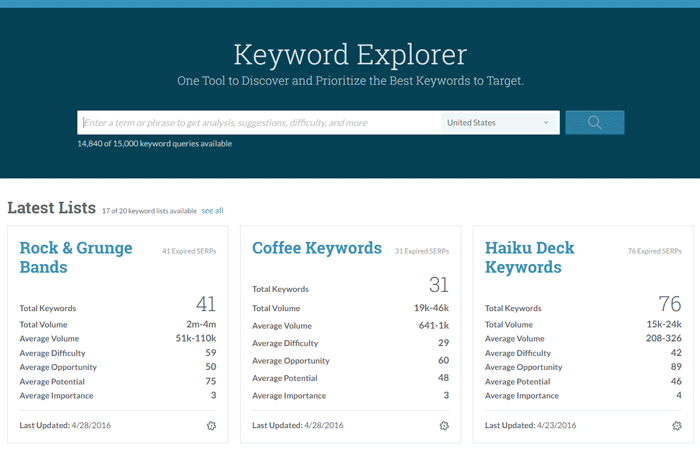How to Create a Keyword List That Works
Table of Contents

An effective keyword list will help you repeatedly rank on the first page of Google.
Whether your goal is getting more blog subscribers, demo requests, direct sales, or simply increasing brand awareness, ranking on the first page of Google is a tremendous achievement, and a key part of any SEO plan. But regardless of your motives, the first step to ranking content is organizing your keyword research and prioritizing your best attempts into an organized keyword list.What are the pros and cons of creating a keyword list?
This is an important question, since it not only takes effort to create your keyword list, but you'll have to do additional work to keep the list updated over time. Here are some benefits of using a keyword list:- Use a keyword list to inform and map out an editorial calendar. If this is your first time creating an editorial calendar, don’t go too crazy. Just get started and map out the next one-to-two months. After that, map out the next three-to-six months. The hard part isn’t having enough ideas to fill up six months worth of blog posts and white papers. The hard part is coming up with ideas and keywords that get closer and closer to your audience, and what you want them to do. So start small and build a better content empire over time. (Progress, not perfection!)
- Use a keyword list to focus your content creation efforts. There are too many things to write about, only a few things that your audience cares about, and even fewer hours in the day. The keyword list will be your friend when it comes to working smarter and maximizing the impact of your work. The keyword list coupled with your editorial calendar will help estimate how much time you need to research one topic, and hopefully amplify that work over several pieces of content.
- Use the keyword list to get more out of existing content by helping you focus on backlinking and promoting. This is your opportunity to create a full list of what you’ve created and connect it to the keywords that you want to win. You may find that some of your content is already ranking for keywords on your list, which means your next task is to optimize the content and pitch it to blogs and social influencers, to help your work climb up the ever-important ranks of Google.
- Creating and managing a keyword list takes time and commitment. While it’s worth the exercise since it allows you to work smarter, creating and managing a keyword list does take time. My advice: Bite the bullet and set aside three or four hours to lay down the foundation for your keyword research and list. Once that’s out of the way, (and hopefully with the help of creative and supportive teammates) the rest of the list and prioritization will flow easily. A keyword list might constrain you and narrow your content world. The keyword list is only representative of what you and your team are aware of — be it about a product, industry, or target audience. The danger of this is missing out on the wonderful universe of other content creators and experts that you’re not aware of. So keep yourself flexible, create space to stay creative, and be open to new ideas that don’t show up on your initial keyword list.
Six Steps to Create and Prioritize a Keyword List
Step 1: Audience In this tab, write down what you know about your buyers, what’s important to them and when, and important dates to track. Your buyer (or whoever you consider to be your audience) should always be front and center during this exercise. If you already have personas mapped out to the typical sales cycle, refer back to that while you start writing categories of keywords. If you’re still learning about your buyer, it's a good idea to go through the classic persona exercise, but if you’re short on time and need to move quickly, you can do the following two things to put yourself in the shoes of your buyer:- Get knowledge transferred from someone in a sales or product role. This person is likely 100% focused on what’s important to your target customer and will help you get closer to what’s true for your customer.
- Listen to sales calls. Sales calls and notes hold a wealth of information, and will allow you to pick up a lot of non-verbal queues as your target buyer engages directly with your team/product.
- Who is your buyer?
- What are you trying to convince them to do with your content?
- Intersections between your buyer and your product
- Areas where you or someone on your team is a product or industry expert
- Concerns that are important to your buyer and are at least tangentially related to your product
- In the same keyword tab, create a column to track average monthly search volume.
- Sign into Google AdWords.
- Go to Keyword Planner under Tools.
- Go to Get Search Volume Data and Trends.
- Cut and paste your list of keywords.
- Adjust targeting.
- Download your results and update your keyword list.
- Score a “1” for keywords that are closest to your goal. If you sell boutique pet food, then the keyword for “best grain-free dog food” would score a “1”.
- Score a “2” for keywords that imply someone is taking action, but not necessarily looking for dog food. For example, a “2” might be “help dog lose weight” or “healthy diet for dog.”
- Score a “3” for keywords that are flat, not necessarily actionable, and more focused on education. Some examples are, “what is kibble” or “types of dog food.” The topic is relevant since you sell pet food, but there are too many reasons why a person might want to learn what is kibble and too many of them are not real buyers.
About Esther Kim

I started my career working for a large tech company, creating content for a niche analyst group. Then, I moved to my first start up and never looked back. For the past six years, I’ve been in content and lead generation. Every single day, I work on marketing campaigns, content strategy, and content generation aimed at getting products in front of real buyers. Every single day, I find new ways to appreciate the world of content marketing — both the art and the science behind it. This is for all the budding content marketers and overworked marketing consultants out there wondering how to get keywords to work for you.






